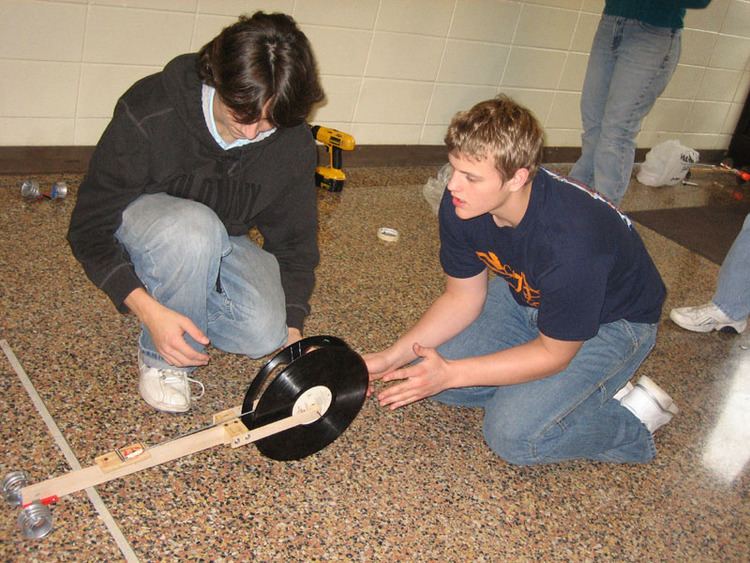 | ||
A mousetrap car is a small vehicle whose only source of motive power is a mousetrap. Variations include the use of multiple traps, or very big rat traps, for added power.
Contents
Mousetrap cars are often used in physics or other physical science classes to help students build problem-solving skills, develop spatial awareness, learn to budget time, and practice cooperative behavior.
Design
The general style for a mousetrap car varies. A number of commercial vendors offer plans, kits and complete cars for sale. In addition to mousetrap cars, contests have been created for mousetrap boats. and mousetrap airplanes.
Spring power
A mousetrap is powered by a helical torsion spring. Torsion springs obey an angular form of Hooke's law:
where
The energy of U, in joules, stored in a torsion spring is:
When a mousetrap is assembled, the spring is initially twisted beyond its equilibrium position so that it applies significant torque to the bar when the trap is closed.
Power transmission to axle
This motion must be used to turn the car's axle or wheels. The most common solution is to attach a string to the mouse trap's arm and then wrap it around an axle. As the bar is released, it pulls on the string, causing the axle (and wheels) to turn.
Tying the string directly to the mousetrap's bar, however, will not make good use of the energy stored in the spring. The distance between the opened and closed positions of the bar of a mousetrap is typically 10 cm, so this is how much string would be pulled. Wrapped around even a small diameter axle, this amount of string will not create enough revolutions to move the car as far as it might go.
To get around this problem, most mousetrap cars add a lever to the bar so that the lever will pull a much greater length of string and cause the axle to turn many more revolutions.
Friction of wheels
Another reason to add a lever to the mousetrap bar is to reduce the amount of torque applied to the wheels. If too much torque is applied to the wheels, the force between the wheels and the ground will exceed the maximum frictional force due to the coefficient of friction between the wheel and ground surfaces. When this happens, the wheels slip and energy stored in the spring is wasted. Using a long lever on the mousetrap bar reduces the tension in the string due to the spring's torque, and thus reduces the torque applied to the car's wheels.
In addition to reducing the torque applied to the wheels, the coefficient of friction may be improved by using higher friction materials.
Lab example
PURPOSE: To construct a "car" that can be run on the energy stored in the coil-spring of a mousetrap. The car must be designed and built to travel the greatest horizontal displacement. The students should apply the principles learned in studying Newton’s Laws and Rotational Mechanics in a practical way. Materials: (1) Mousetrap (a single 1 ¾” x 3 7/8 ” Victor, Enforcer or a similar approved brand) (2) Wheels – may be cut, scavenged, purchased or built. (3) Chassis – wood, metal, plastic, etc… It must not be store-bought or purchased on the internet as final form. KITS OR PARTS OF KITS ARE NOT ALLOWED – REDUCED CREDIT FOR HOBBY SHOP PARTS READY-MADE. Rules and Guidelines: (1) You must use Victor, TomCat or Enforcer brand mousetraps – all three are acceptable. All traps must be approved; in no case will a mousetrap trap larger than 2 inches x 4 inches be acceptable. (No “rat” traps.)
(2) All of the power for your mousetrap car must come from the one trap. You must touch the release mechanism of the mousetrap to get the car started, but you may not push it forward in any way.
(3) Everyone is required to build their own mousetrap car. You may get help from an adult for small portions of the construction, but it must be your own design
(4) No dimension of the car may be more than 1.0 m in length, height or width. All cars must have at least 3 wheels and two axles. The car must roll along the floor.
(5) The spring from the mousetrap cannot be altered or heat-treated. An extension arm may be added.
DO NOT REMOVE ANY PART OF THE MOUSETRAP. The trap release must not be removed – it is the only starting mechanism for the car.(6) Cars must be self-steering. You may not guide the car once you have started it. Measurements of distance are actually displacement along a straight-line course.
(7) All parts of the car must travel with your car. Nothing may fall off, be thrown, or be left behind.
(8) Each student will be given 2 chances to make the car move during the class time-trials. The best trial (your choice of the two) will count for points. You must be ready on your assigned day.
(9) You must plainly mark your name and section on an upper easy-to-read part of your car. Your car may
not be painted to cover the raw materials used on the car. You must build your car from scratch.(10) The teacher will be the final judge of the appropriateness of any materials used in the construction of the car.
If in doubt, check far in advance! KITS OR PARTS OF KITS ARE UNACCEPTABLE!